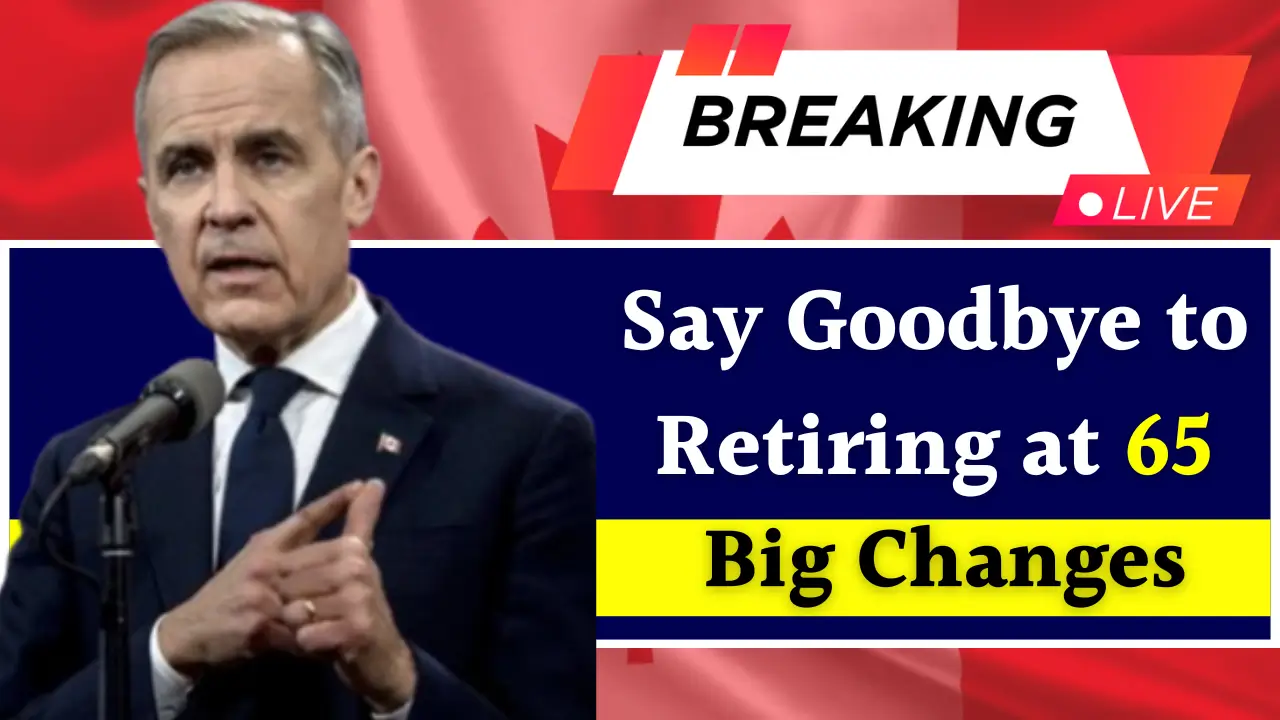Say Goodbye to Retiring at 65 in Canada: For generations, Canadians have grown up hearing that retirement begins at 65, with government-backed programmes like Old Age Security (OAS) and the Canada Pension Plan (CPP) providing financial support. But new demographic pressures, rising life expectancy, and policy adjustments are changing the age at which these benefits become most valuable.
Today, retiring at 65 is no longer the single standard — flexibility and gradual adjustments are becoming the norm.This article explores how OAS and CPP are evolving, what the “new retirement age” really means, and how Canadians can prepare themselves for these significant changes.
The Traditional Age 65 Retirement Model
Retirement at 65 was once considered the Canadian golden rule. When OAS was created in 1952, average life expectancy was much lower, and many people spent only a decade or so drawing benefits. Similarly, the Canada Pension Plan (introduced in 1966) assumed that workers would stop working at age 65, with contributions providing retirement income for the years that followed.
However, several realities have now changed:
- Life expectancy in Canada has risen to about 82 years.
- Financial independence today often requires a longer savings period.
- More seniors continue working past 65, not only out of need but also for personal fulfilment.
These factors put pressure on old assumptions. As a result, the definition of retirement age in Canada is shifting.
OAS Changes and Flexibility
Old Age Security remains one of the fundamental income supports for Canadian seniors. Currently, Canadians can start receiving OAS at 65, but they can also defer it up to age 70. For every month of delay, OAS payments increase by 0.6%, meaning someone waiting until age 70 would receive up to 36% more in monthly benefits.
This means that many Canadians who can afford to wait may choose a later start date, ensuring larger lifelong income. At the same time, early collection remains an option for those unable to wait due to health or financial needs.
The Canada Pension Plan (CPP) Adjustments
Much like OAS, the CPP has undergone significant transformation. Workers can choose to begin collecting CPP retirement benefits as early as 60 or as late as 70.
- If collected at 60, the pension amount is reduced permanently (by 0.6% per month before 65, or 36% in total).
- If delayed until 70, the pension amount grows permanently (by 0.7% per month after 65, or 42% in total).
This flexibility fundamentally changes retirement planning. Instead of thinking of retirement as a fixed age, Canadians now consider their own health, career, and financial situation before starting CPP.
The New “Retirement Age” in Canada
While 65 remains the standard eligibility marker, the true “new retirement age” is more fluid. The government has not mandated a higher age, but Canadians are encouraged to work longer and delay benefits if possible.
Many financial experts now point to age 67 to 70 as the “new normal” for maximising OAS and CPP benefit amounts. This reflects the reality that Canadians are living much longer and therefore need stronger retirement income streams.
This shift aligns with global patterns. In many OECD countries, retirement ages are rising toward 67 or higher. Canada has, so far, kept 65 as the official marker but designed its programmes to reward later retirement.
Benefits of Delaying OAS and CPP
The incentive for Canadians to push beyond 65 lies in improved financial stability. Consider:
- Longer lifespans mean retirement can last 20 to 30 years.
- Health improvements allow more seniors to work into their late 60s.
- Larger benefits provide inflation protection as costs of living rise.
For example, below is a comparison of benefit amounts for someone with the same entitlement but different starting ages.
OAS and CPP Benefit Comparison by Age
| Age Benefit Starts | OAS Monthly Benefit* | CPP Monthly Benefit* | Total Retirement Income |
|---|---|---|---|
| Age 60 (CPP only) | N/A | Reduced by 36% | Lower than standard |
| Age 65 | Standard OAS amount | Standard CPP amount | Base retirement income |
| Age 67 | +14.4% on OAS | +16.8% on CPP | Moderately higher |
| Age 70 | +36% on OAS | +42% on CPP | Significantly higher |
*Example figures depend on individual contributions and government rates.
This table highlights how deferring can contribute to much greater monthly income, which is crucial in long retirements.
Impact on Canadians’ Retirement Planning
The flexibility of OAS and CPP means Canadians must make more personalised choices. Gone are the days when everyone simply stopped at 65. Instead, factors such as the following are now more relevant:
- Health outlook: Those with shorter life expectancy may opt to collect earlier.
- Career goals: Professionals who enjoy work often continue past 65.
- Financial stability: Those with adequate private pensions or savings may delay OAS and CPP for larger returns.
- Cost of living: Urban centres with higher expenses may push individuals to continue working and defer benefits.
Retirement Is Becoming More Individualised
The Canadian retirement landscape is no longer uniform. Instead, it is shaped by personal preference, economic need, and government flexibility. This trend reflects a broader shift toward individual decision-making, where retirement is not a set date but a financial strategy.
Another implication is that younger Canadians entering the workforce should begin saving earlier and plan with the assumption that government support may come later than 65. This creates greater responsibility for personal financial planning.
Challenges with Delaying Retirement
While delaying may be financially rewarding, it is not possible for everyone. Some challenges include:
- Poor health – Many individuals cannot continue working into later years.
- Job opportunities – Older workers may struggle to find employment past 65.
- Immediate financial needs – Some retirees need CPP and OAS as soon as possible to afford necessities.
This underlines why flexibility is key: Canadians can start as early as 60 or wait until 70, depending on life circumstances.
Preparing for the Future of Retirement in Canada
To adapt to this evolving retirement age structure, Canadians must focus on three key areas:
- Early financial planning – Contributing to RRSPs, TFSAs, and private pensions ensures more control over retirement timing.
- Health and career development – Staying healthier and developing career adaptability allows work later in life if desired.
- Maximising government benefits – Understanding the long-term rewards of delaying OAS and CPP ensures informed choices.
The idea that 65 is the firm line in retirement is fading. Instead, Canadians should plan for flexibility and resilience.
FAQs
1. What is the basic eligibility age for OAS in Canada?
The standard eligibility age remains 65, but OAS can be deferred up to 70 for more benefits.
2. Can I take CPP at 60?
Yes, you can start CPP at 60, but your monthly benefit is permanently reduced by up to 36%.
3. Why would someone delay OAS or CPP?
Delaying provides significantly higher monthly benefits, which are especially helpful for longer retirement periods.
4. Is the government planning to raise the official retirement age beyond 65?
Canada has not officially increased the retirement age, but the system increasingly rewards waiting past 65.
5. What is considered the new retirement age in Canada?
While still flexible, financial advisers often view 67–70 as the new “ideal” retirement window for maximising benefits.
Conclusion
Say goodbye to retiring at 65 — it is no longer the automatic endpoint of Canadian working life. With OAS and CPP allowing deferrals up to age 70, and financial incentives for waiting, Canadians must rethink how and when they step into retirement. The new “normal” is not a fixed age but a flexible set of options tailored to each individual’s financial and personal situation. For most, the best outcomes may now come between 67 and 70, not 65.















